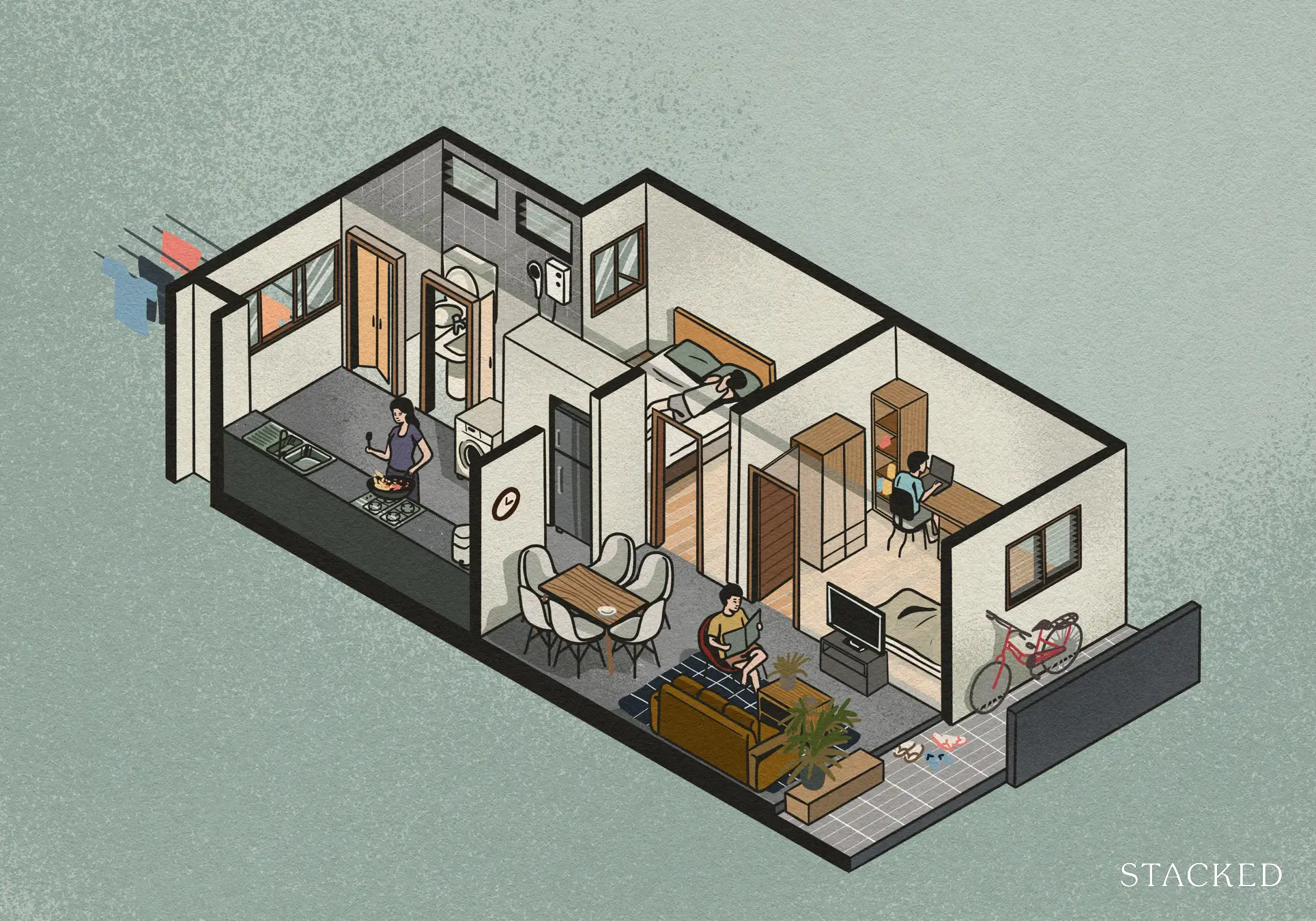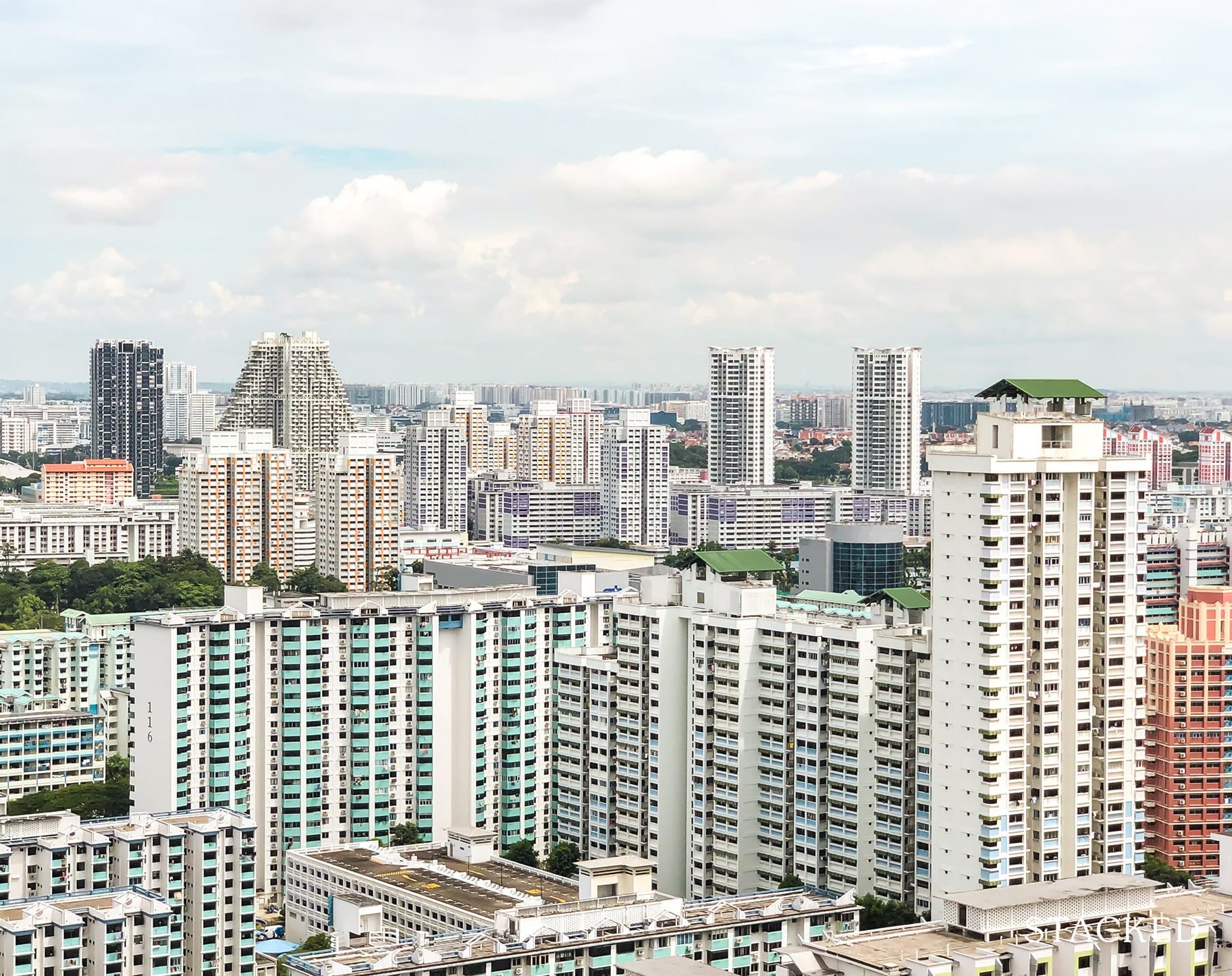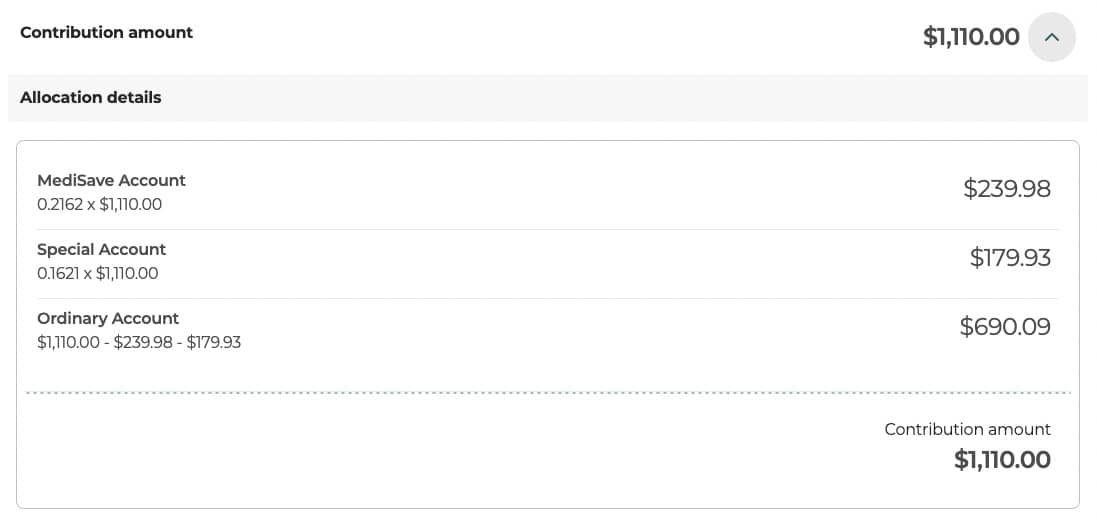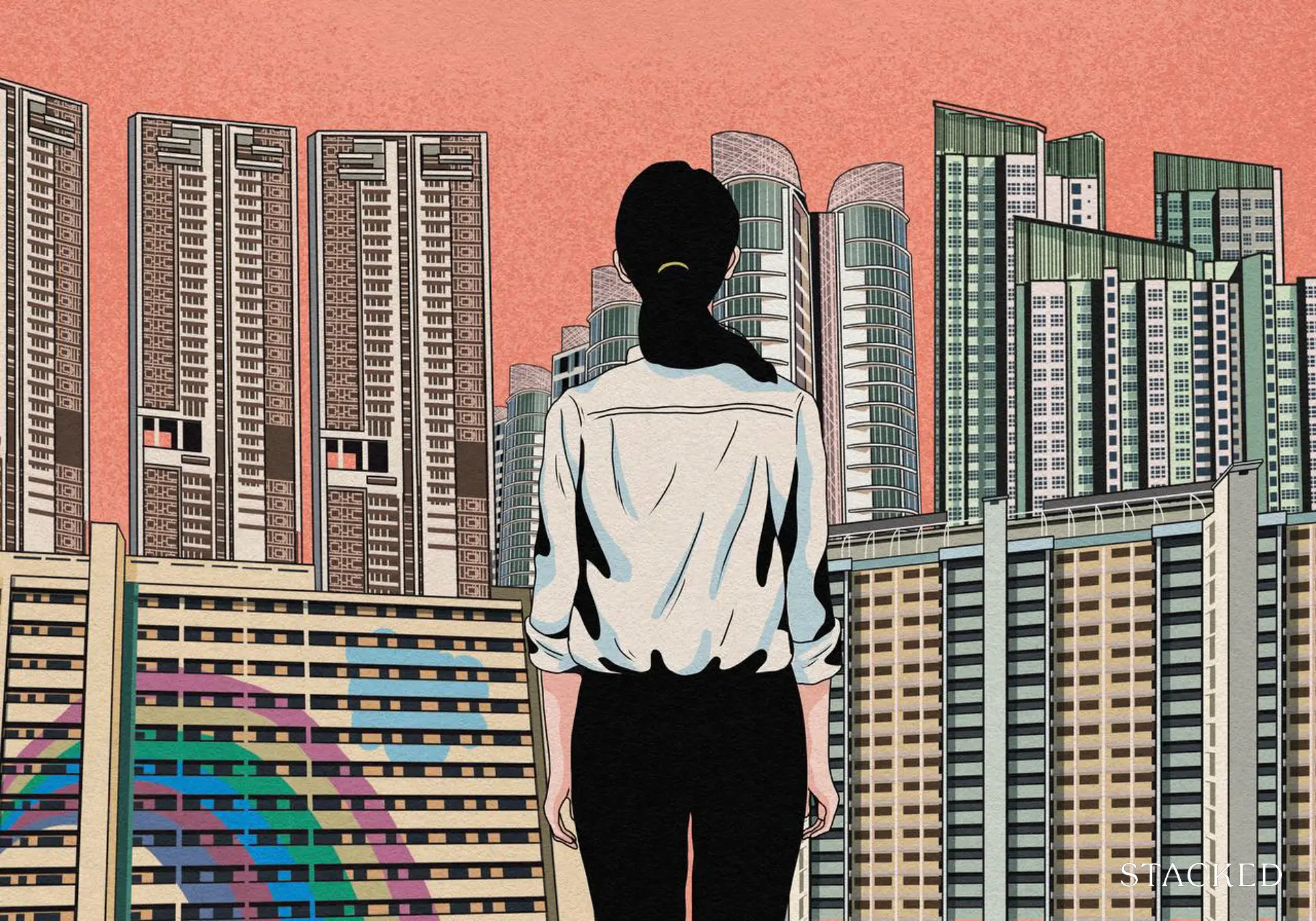Are 3-Room HDB Flats Still Affordable For Singles In 2024? Here’s The Reality

Get The Property Insights Serious Buyers Read First: Join 50,000+ readers who rely on our weekly breakdowns of Singapore’s property market.
Melody is a designer who currently works in Tech and writes for fun. Her latest obsession is analysing and writing about real estate affordability for the younger generation. Coming from an Industrial Design background, she has a strong passion for spatial design and furnishing . Having worked in Finance for almost a decade, Melody has a keen interest in sustainable investments and a nose to sniff out numbers that don't make sense.
As younglings under 35, one of the major annoying topics among single friends is affordability when it comes to owning a resale flat in Singapore.
“It’s so freaking expensive! And we will always get outbid by couples with dual income.”
With your chances of success balloting for a 2-room flexi to be an average of 14.9%, based on the 2023 Supply and Application Report by HDB themselves, I can see why many of my friends aren’t counting on getting a BTO and anticipating forking out premium coin to get a resale.
With better location options and a quicker turnaround time from sale to moving into their new home, many youths consider resale flats to be worth the money so they can get one of their biggest life purchases out of the way as soon as possible.
But this might not be an option for many, as affordability always comes into play with big purchases.
So the question remains, how much do you really need to comfortably afford a resale flat as a single Singaporean in 2024?
Here’s a look at the average 3-room flat prices across all HDB estates so far in 2024. Do note that I’ve only taken flats that have transacted this year and have at least 60 years left on the lease. This is to ensure that you’d be able to stay there till 95! In this case, there were only 1,353 transactions up till early June 2024.
| Estate | 3 Room Flat Price |
| Bukit Batok | $407,441 |
| Bukit Panjang | $407,578 |
| Jurong West | $411,385 |
| Jurong East | $415,536 |
| Yishun | $420,001 |
| Choa Chu Kang | $423,068 |
| Serangoon | $427,333 |
| Woodlands | $429,254 |
| Bedok | $432,679 |
| Hougang | $438,587 |
| Sembawang | $457,540 |
| Sengkang | $476,315 |
| Tampines | $485,921 |
| Punggol | $489,702 |
| Bishan | $506,278 |
| Central Area | $524,487 |
| Pasir Ris | $558,710 |
| Geylang | $567,423 |
| Ang Mo Kio | $572,907 |
| Clementi | $634,017 |
| Kallang/Whampoa | $638,233 |
| Queenstown | $665,972 |
| Bukit Merah | $693,913 |
| Toa Payoh | $724,823 |
| Average | $474,771 |
3-room flat prices range, on average, from $407k up to $725k, which is a pretty wide range. Toa Payoh for example, has many old flats, however, some newly-MOP flats may have dominated the 2024 transactions so far – so this isn’t a fully-accurate view of what each estate flats are worth on average.

Nonetheless, for simplicity’s sake, we’ll assume that it costs $475,000 to purchase a 3-room flat in 2024 as this was the average across the year so far.
How much do you need to afford a 3-room flat in Singapore?
So now that we know the average cost of a 3-room flat, let’s talk about the different scenarios you could be in. Everyone’s financial situation will be different, so here’s a look at the different monthly incomes, the maximum monthly mortgage as well as the maximum loan and flat price:
| Salary (Gross) | Max Monthly Mortgage | Max Loan (80%) | Downpayment (20%) | Max HDB Affordability |
| $2,000 | $600 | $126,526 | $31,631 | $158,200 |
| $2,200 | $660 | $139,178 | $34,795 | $174,000 |
| $2,400 | $720 | $151,831 | $37,958 | $189,800 |
| $2,600 | $780 | $164,484 | $41,121 | $205,600 |
| $2,800 | $840 | $177,136 | $44,284 | $221,400 |
| $3,000 | $900 | $189,789 | $47,447 | $237,200 |
| $3,200 | $960 | $202,441 | $50,610 | $253,100 |
| $3,400 | $1,020 | $215,094 | $53,773 | $268,900 |
| $3,600 | $1,080 | $227,747 | $56,937 | $284,700 |
| $3,800 | $1,140 | $240,399 | $60,100 | $300,500 |
| $4,000 | $1,200 | $253,052 | $63,263 | $316,300 |
| $4,200 | $1,260 | $265,704 | $66,426 | $332,100 |
| $4,400 | $1,320 | $278,357 | $69,589 | $347,900 |
| $4,600 | $1,380 | $291,010 | $72,752 | $363,800 |
| $4,800 | $1,440 | $303,662 | $75,916 | $379,600 |
| $5,000 | $1,500 | $316,315 | $79,079 | $395,400 |
| $5,200 | $1,560 | $328,967 | $82,242 | $411,200 |
| $5,400 | $1,620 | $341,620 | $85,405 | $427,000 |
| $5,600 | $1,680 | $354,272 | $88,568 | $442,800 |
| $5,800 | $1,740 | $366,925 | $91,731 | $458,700 |
| $6,000 | $1,800 | $379,578 | $94,894 | $474,500 |
| $6,200 | $1,860 | $392,230 | $98,058 | $490,300 |
| $6,400 | $1,920 | $404,883 | $101,221 | $506,100 |
| $6,600 | $1,980 | $417,535 | $104,384 | $521,900 |
| $6,800 | $2,040 | $430,188 | $107,547 | $537,700 |
| $7,000 | $2,100 | $442,841 | $110,710 | $553,600 |
| $7,200 | $2,160 | $455,493 | $113,873 | $569,400 |
| $7,400 | $2,220 | $468,146 | $117,036 | $585,200 |
| $7,600 | $2,280 | $480,798 | $120,200 | $601,000 |
| $7,800 | $2,340 | $493,451 | $123,363 | $616,800 |
| $8,000 | $2,400 | $506,103 | $126,526 | $632,600 |
| $8,200 | $2,460 | $518,756 | $129,689 | $648,400 |
| $8,400 | $2,520 | $531,409 | $132,852 | $664,300 |
| $8,600 | $2,580 | $544,061 | $136,015 | $680,100 |
| $8,800 | $2,640 | $556,714 | $139,178 | $695,900 |
| $9,000 | $2,700 | $569,366 | $142,342 | $711,700 |
| $9,200 | $2,760 | $582,019 | $145,505 | $727,500 |
| $9,400 | $2,820 | $594,672 | $148,668 | $743,300 |
| $9,600 | $2,880 | $607,324 | $151,831 | $759,200 |
| $9,800 | $2,940 | $619,977 | $154,994 | $775,000 |
| $10,000 | $3,000 | $632,629 | $158,157 | $790,800 |
Now let’s get into the different affordability scenarios, please note that we won’t be taking grants into consideration.
Scenario #1: For those earning a lower income in Singapore
We’ll first consider the situation of someone in the lower income bracket.
We’ve heard some sentiments that our content can be a bit elitist: It’s not that we don’t want to acknowledge what affordability means for those in a lower-income band, but it’s quite hard to crunch impossible numbers and sell you a false dream.
As such, so we decided to do a calculation for those on a S$3,000 salary band.
Technically at the 30% MSR rate and a 20% downpayment, the maximum 3-room flat someone with a S$3,000 salary can afford is just around S$237,200.
This is very low for 2024. It’s just 60% of the average resale flat price of the cheapest estate in the table above, Jurong East. In any case, you can’t even consider BTOs due to the ineligibility of Singles to buy a 3-room flat, so this effectively prices you out unless you have the requisite savings to meet the MSR requirement.
So what would that look like?
If the maximum price of a flat someone on a S$3,000 salary can afford is S$237,200, then that person would need to top up S$237,800 in downpayment (CPF or cash) to afford a S$475,000 3-room flat.
This certainly sounds like a lot of money to save up for someone on a S$3,000 salary at 35. Assuming this person works for 10 years, that’s saving S$23,780 from age 25 consistently. This represents around 66% of the person’s annual income.
What if this person only uses their CPF? Let’s consider both the employee and employer’s CPF contributions:

Assuming this person uses all their CPF savings, they would have just S$82,810.80 saved up over 10 years – and this assumes they’ve been earning this amount from 25. The actual amount would likely be less.
So unless you’ve struck the lottery or are a very good saver and managed to come up with the cash (somehow?), being a proud owner of a S$475,000 3-room flat on a S$3,000 salary is almost impossible.
Even if you do add the CPF Housing Grants available for singles, the amount would barely be enough to afford even the cheapest transacted 3-room flat in 2024 so far that has at least 60 years left.
More from Stacked
I Bought A $3M Leasehold Cluster Housing Home And I Have No Regrets
Cluster housing is a bit of an unusual property choice that most wouldn't think about immediately. A lot of Singaporeans…
Now let’s talk about the other affordability scenario: one where you make more money.
Scenario #2: For those making the median salary in Singapore
The common train of thought is that single resale buyers are usually high flyers at their jobs fetching higher salaries. The question now is, how high up the percentile do you need to be to afford it comfortably?
Let’s consider a single person who is at the 50th percentile in income – a median salary of S$5,598 monthly.
| Item | Amount |
| Salary | $5,598 |
| Mortgage Servicing Ratio (30%) | $1,679 |
| Max Loan (At MSR, 3% Interest Rate) | $354,146 |
| Downpayment | $88,536 |
| Total Flat Price | $442,682 |
With that salary, your max monthly contribution allowance for your mortgage stands at S$1,679. Even if you earn the median salary, you’d still have to top up S$22k more in downpayment to qualify for a S$465,000 flat. So your actual required downpayment amount is around S$110,856.
And this is just the average for 2024. For someone earning a median income looking at a mature estate, such as those in Clementi or Queenstown, they need to top-up another S$100k! That’s ~S$210k in cash/CPF to cough up!
So it seems that having a median salary would help you make the cut for the cheaper resale options, and having a high savings rate on top of this would help unlock more 3-room resale options as a single in 2024.
But from this analysis, it seems that even the median salary isn’t going to quite cut it. You’ll probably need to be earning more.
After-care: Adding FIRE to the equation
As a single person who theoretically wouldn’t get married nor have children, the nice thing is that you won’t birth additional dependents with increasing costs as you age up, but this also means you are solely responsible for your own finances as you get older.
And since a mortgage is going to be a continued, long-term big expense, how does one ensure we can comfortably pay off high mortgages well past our career primes, without having to downgrade?
This is where FIRE comes in.
You may have already heard about the FIRE movement from The Woke Salaryman or similar creators, but it is basically the shortened term for “Financial Independence, Retire Early”. We thought of exploring this scenario given the chatter around it over the past number of years.
For the uninitiated, this is a strategy that encourages people to save and invest aggressively to retire well before the traditional retirement age (which is commonly accepted to be 65).
As the name suggests, the strategy is made up of two components
- Financial Independence: The accumulation of wealth so that one’s investment returns can sustain the cost of living indefinitely. The rule of 4% of the total invested amount applies here. For example, someone with an invested amount of $1 million can withdraw $40,000 annually without depleting this invested amount.
- Retire Early: Having an earlier retirement date provides more time for things like travelling, pursuing hobbies and so on. The earlier you wish to retire, the more aggressively you have to save and invest.
For our analysis, we set the retirement flagpole at 50 years old.
Now let’s say you’ll be making the median income for the next 15 years. Here’s what the cash leftovers would look like based on a $1,500 monthly expense (which isn’t too uncomfortable):
| Item | Amount |
| Income | $5,598 |
| Take-home (80%) | $4,478 |
| Less Expenses (Monthly) | $1,500 |
| Less Taxes (Based on YA2024 calculations, less rebates) | $126 |
| Less Mortgage after CPF | $319 |
| Leftover Cash | $2,534 |
This results in savings of about $2,500 a month. Assuming you invest all of it, the next 15 years with a 7% equities portfolio would look like the following:
| Age | Portfolio | Gains | 4% Withdrawal |
| 35 | $30,000 | $2,100 | $1,200 |
| 36 | $62,100 | $4,347 | $2,484 |
| 37 | $96,447 | $6,751 | $3,858 |
| 38 | $133,198 | $9,324 | $5,328 |
| 39 | $172,522 | $12,077 | $6,901 |
| 40 | $214,599 | $15,022 | $8,584 |
| 41 | $259,621 | $18,173 | $10,385 |
| 42 | $307,794 | $21,546 | $12,312 |
| 43 | $359,340 | $25,154 | $14,374 |
| 44 | $414,493 | $29,015 | $16,580 |
| 45 | $473,508 | $33,146 | $18,940 |
| 46 | $536,654 | $37,566 | $21,466 |
| 47 | $604,219 | $42,295 | $24,169 |
| 48 | $676,515 | $47,356 | $27,061 |
| 49 | $753,871 | $52,771 | $30,155 |
| 50 | $836,642 | $58,565 | $33,466 |
As you can see, by age 50, owning an equities portfolio that grows at 7% annually allows you to withdraw $33,466 per year. This may seem well above the $1,500 monthly spend, however, retiring on just $2,789 monthly doesn’t seem that ideal.
Since mortgage payments will be an expenditure deducted from your monthly $2,789, that only leaves you with $970 a month left over. Depending on perspective, that can be a lot, but as insurance premiums rise with age and with you treating yourself occasionally in your retirement, the amount is likely much lesser. So you’re barely breaking even.
You will get your pension once your CPF is unlocked, which increases your monthly allowance. But if you’ve spent most of your CPF on your resale property it means you cannot depend so much on CPF either. This is when most retirees consider selling and downgrading.
What if you really want to keep your flat? Well, you’ll basically have to achieve $5,000 in passive income per month by the age of 50. This means having to achieve a portfolio of $1.5 million dollars by that age.
Using numbers to (attempt) to secure your financial future
Assuming that we don’t adjust our $1,500 expenditure, what can we control or adjust to ensure we’re financially sound after our resale flat purchase?
One thing we can control is the monthly payments towards the property. So we can choose to buy a more affordable property, use less money for the downpayment, and invest more initially into your portfolio.
Let’s assume the purchase of a cheaper flat. In this example, we’ll do $400,000 which is quite doable in today’s market.
| Item | Amount |
| Salary | $5,598 |
| Flat Price | $400,000 |
| Downpayment | $80,000 |
| Loan Amount | $320,000 |
| Monthly Mortgage | $1,452 |
The main difference now is the downpayment. Compared to $465k which required S$110,536 (more than 20% of S$465K due to the MSR), you’d only require S$80,000 this time around. This means you’ll get to set aside the extra S$30,854 for your FIRE portfolio.
Additionally, your monthly mortgage is slightly lower too, so you can invest more:
| Item | Amount |
| Income | $5,598 |
| Take-home (80%) | $4,478 |
| Less Expenses (Monthly) | $1,500 |
| Less Taxes (Based on YA2024 calculations, less rebates) | $126 |
| Less Mortgage after CPF | $164 |
| Leftover Cash | $2,688 |
Here’s what the investment over 15 years looks like:
| Age | Portfolio | Gains | 4% Withdrawal |
| 35 | $63,110 | $4,418 | $2,524 |
| 36 | $99,784 | $6,985 | $3,991 |
| 37 | $139,025 | $9,732 | $5,561 |
| 38 | $181,012 | $12,671 | $7,240 |
| 39 | $225,939 | $15,816 | $9,038 |
| 40 | $274,011 | $19,181 | $10,960 |
| 41 | $325,448 | $22,781 | $13,018 |
| 42 | $380,485 | $26,634 | $15,219 |
| 43 | $439,375 | $30,756 | $17,575 |
| 44 | $502,387 | $35,167 | $20,095 |
| 45 | $569,810 | $39,887 | $22,792 |
| 46 | $641,953 | $44,937 | $25,678 |
| 47 | $719,146 | $50,340 | $28,766 |
| 48 | $801,742 | $56,122 | $32,070 |
| 49 | $890,120 | $62,308 | $35,605 |
| 50 | $984,684 | $68,928 | $39,387 |
By 50, the 4% withdrawal rate goes close to S$40,000. This is around $3,292 per month. That’s $503 more monthly than the previous projection.
So after one big round, opting for a cheaper 3-room flat doesn’t really make a life-changing difference to one’s FIRE goals. The only way to improve this is to extend the retirement age, so compound interest works better in your favour. You might not get to FIRE, but at least you used the concepts to put yourself in a better position (or see how it can help you).
The most pragmatic way to get over this conundrum is to simply earn more money, likely above the median. It’s easier said than done, but such is reality.

Conclusion
Since there have been a lot of words and numbers in between the original context, I would like to remind everyone that all these calculations are done for average 3-room resale flats.
All numbers are based on historical pricing trends, and the exercises done here are also purely theoretical.
I’m not a financial advisor, and I haven’t gone into great detail with the numbers – especially with the FIRE portion (so I’ve not included things like voluntary CPF contributions to reduce tax income, asset management fees, and all the fun stuff you need to think about when you invest).
In conclusion, we’ve looked at 3-room flat prices you can afford based on different income levels as well as 2 different scenarios; (not) affording a home on a lower income, (barely) affording a home on median income, and explored using FIRE concepts to afford a cheaper resale with (slightly) less retirement worries.
As for how to plan your finances and get to your ideal state, and what that ideal state looks like, we leave that up to you.
Either way, we hope our readers will be able to progress in their financial journey to be able to find options within their affordability down the line, be it locally or overseas.
If you’d like to get in touch for a more in-depth consultation, you can do so here.
Melody Koh
Melody is a designer who currently works in Tech and writes for fun. Her latest obsession is analysing and writing about real estate affordability for the younger generation. Coming from an Industrial Design background, she has a strong passion for spatial design and furnishing . Having worked in Finance for almost a decade, Melody has a keen interest in sustainable investments and a nose to sniff out numbers that don't make sense.Read next from Editor's Pick

Property Market Commentary I Lived In Bayshore When It Was ‘Ulu’. Here’s How Much It Has Changed

Property Market Commentary Why The Singapore Property Market Will Be Different In 2026 — And It’s Not Just About Prices

Property Market Commentary 2025 Year-End Review Of The Singapore Property Market: What The Numbers Reveal

Property Market Commentary How The HDB Resale Market Performed In 2025, And What It Means For 2026 Prices
Latest Posts

Singapore Property News This HDB Just Crossed $1.3M For The First Time — In An Unexpected Area

Singapore Property News “I Never Thought I’d Be Sued by a Tenant.” What Long-Time Landlords in Singapore Miss

Singapore Property News HDB Resale Prices Finally Slowed in 2025 — Will It Continue in 2026?

Singapore Property News Breaking News: District 23 Condo Sells Out In Under Two Years At $2,120 Psf Average

On The Market Here Are The Cheapest 3-Bedroom Condos in Central Singapore You Can Still Buy From $1.15M

Pro This 21-Year-Old Condo Didn’t Sell Out Initially, Yet Became A Top Performer

Singapore Property News Why More Land Doesn’t Automatically Fix Housing In Singapore

On The Market Here Are The Cheapest 4-Room HDB Flats in Central Singapore You Can Still Buy From $490K

Pro How A Once “Ulu” Condo Launched In 1997 Became A Top Performer

Singapore Property News Lentor’s First Condo Is Complete — The Early Profits May Surprise You

Property Advice We Own A $800K 1-Bedder And A $1.1M 3-Bedder: Is It Possible To Upgrade To A 4-Bedder Condo?

On The Market These Are Some Of The Cheapest 5-Room HDB Flats Left In Central Singapore

Pro This 698-Unit Ang Mo Kio Condo Launched At The Wrong Time — And Still Outperformed Peers

Singapore Property News $281.2M in Singapore Shophouse Deals in 2H2025 — But That Number Doesn’t Tell the Full Story

Property Investment Insights These Resale Condos In Singapore Were The Top Performers In 2025 — And Not All Were Obvious Winners


